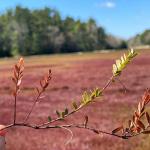Frost update (from Tuesday April 20): EB and H at 20F (white bud stage); BL, ST, and super hybrids at 22 F 9white bud). We had accumulated 99 GDD as of Tuesday April 20.
White bud is the transition stage between spring dormant and cabbagehead, the two stages at which we evaluated Zeus. As buds move out of past spring dormant, the risk of injury from the Zeus application goes up. It is probably too late to apply Zeus on advanced varieties in warm locations at this point (Friday). Late varieties in cool areas could still be good candidates.
No reported bugs on bogs yet this year! Although next weeks warm weather may wake up some caterpillars.
https://web.uri.edu/ipm/2021-em/ RI blueberry reports all winter moth eggs have hatched but caterpillars still too small to see. We do NOT expect any activity in cranberry this year due to local parasite release success. Moth flight very low in Nov/Dec but if you saw moths, or you have a history of trouble, then next week would be a good time to scout or consider treatment.
For the past three weeks we visited several bogs coming out of winter showing symptoms of stress. Multitude of factors (last year’s drought, winter damage and/or upright dieback) could have contributed to these symptoms. This is definitely unusual to see upright dieback symptoms widespread this early in the growing season. Typical symptoms appear in late July to early August. Leela Uppala plated several samples in the lab and most of them tested positive for upright dieback pathogen (Phomopsis vaccinii). Now, as the vine is greening up, the bogs with stressed vines caused by drought and winter damage (not upright dieback) are looking a bit better. Most varieties appear to be affected (ST, BL, EB, CQ). Mullica Queens and Howes may show more damage as they green up. If you observe typical symptoms of upright dieback on 5% or more of the uprights, please get it diagnosed by Leela Uppala. Please drop samples sooner than later. Once the diagnosis is confirmed, if you choose to treat with Bravo or Champ, early season applications at bud break and/or early bud expansion (approximately around mid-May) are proven to give excellent control of the disease. Typical diagnosis requires 2-3 weeks of time. However, as we are getting close to the important fungicide application window, we will try to get results back to you as soon as possible. Contact Leela for more information at suppala@umass.edu or 508-295-2212 (x18). Photos below courtesy of Leela Uppala.
Scale population may have declined due to great parasite infestations and/or winter mortality. If you have populations or suspect scale, get a sample to Marty at the station, or set up a site visit. Scale damage will be more apparent as vines green up.
Growers have had success sanding and pruning this week. Frost watch has begun and different regions are behaving very differently!
Don't forget to check if you are in for a pesticide credit audit this year! If so, find your credit paperwork, and if you are short of credits consider attending our Pesticide Safety Meeting, Tuesday and Wednesday morning this coming week (27/28) on Zoom! Contact Robyn at rmhardy@umass.edu for more information or see our most recent newsletter.

